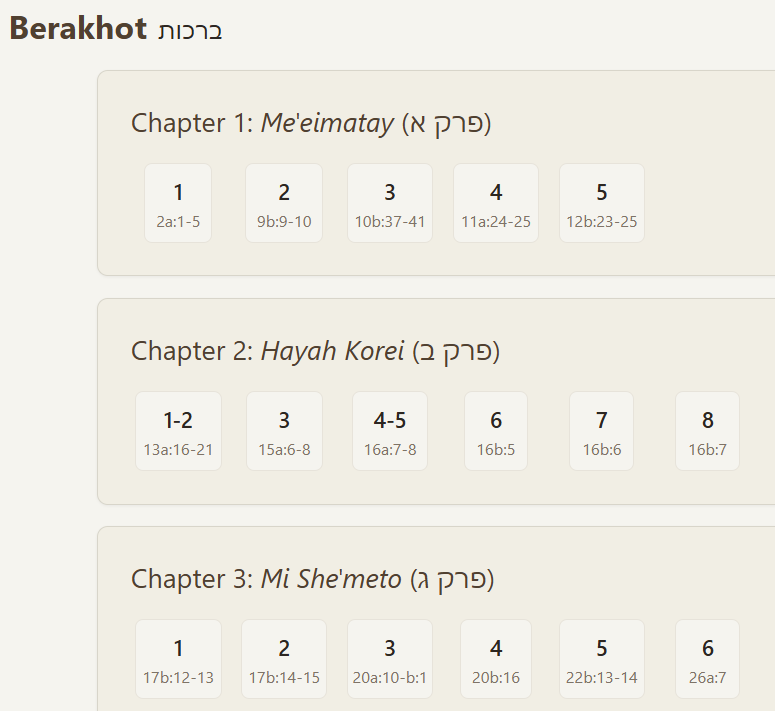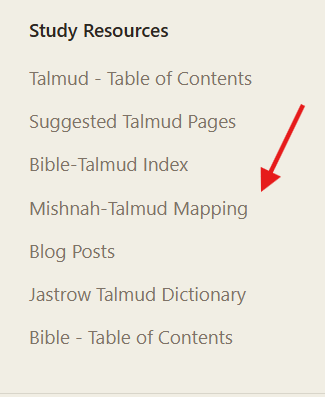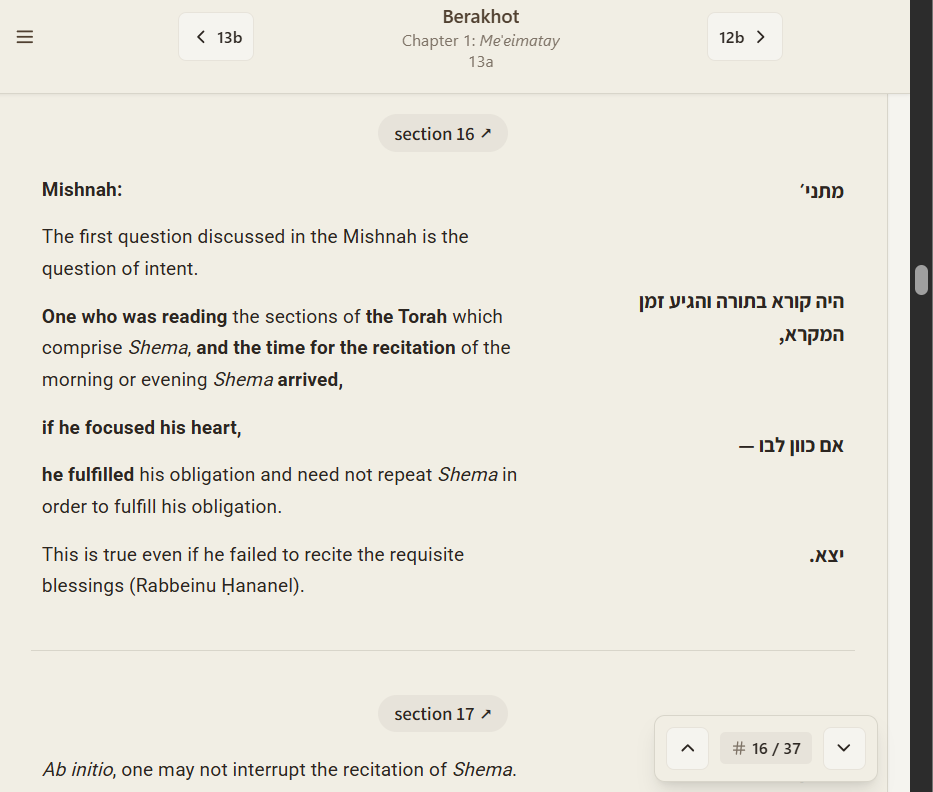Introducing ChavrutAI’s Mishnah-Talmud Mapping Table
When I started building ChavrutAI, I wanted to make the Talmud more more accessible to anyone studying it. One challenge that kept coming up was a simple question: “Where in the Talmud does it discuss this particular Mishnah?”
The Talmud’s structure isn’t always straightforward. The Mishnah—the foundational text of the Oral Torah compiled around 200 CE—is organized by topic. The Talmud, compiled centuries later, discusses (and expands on) each Mishnah in depth. But finding exactly where that discussion happens isn’t always easy. Sometimes a Mishnah appears exactly where you’d expect it, especially when it’s at the beginning of a chapter. Other times, it’s difficult to find.
I’ve now added a comprehensive mapping tool to ChavrutAI that shows you exactly where each Mishnah is discussed in the Talmud Bavli (for the 37 out of 60 Mishnah tractates that have a corresponding Talmud Bavli tractate):
https://chavrutai.com/mishnah-map
It’s based on data from Sefaria’s Mishnah Map, which tracks 2,390 connections between Mishnah passages and their corresponding Talmud locations across all 37 tractates of the Babylonian Talmud.1
Outline
Intro
The Layout
A Concrete Example
Appendix - Technical
Implementation Details
Data Accuracy
The Layout
I designed the page to be the same as ChavrutAI’s main tractate pages. Each Seder is clearly marked with its Hebrew name and description. Under each Seder, tractates are listed in their traditional order. Within each tractate, chapters appear as cards, similar to how the main contents page works.
The Mishnah numbers themselves are displayed as simple buttons arranged in a grid.
For each Mishnah, you’ll see two pieces of information:
The Mishnah number (just the number itself, like “3” or “5-7” if it’s a range)
The specific Talmud section where it’s discussed (in the format “13b:5” meaning page 13b, section 5; according to the section divisions used in the Steinsaltz edition of the Talmud on Sefaria, which ChavrutAI follows.)
Every entry is clickable. When you tap or click on a Mishnah, it takes you directly to that exact location in the Talmud text on ChavrutAI, jumping right to the relevant section on the page.
Screenshot:
https://chavrutai.com/mishnah-map
A Concrete Example
Let’s say you’re interested in Tractate Berakhot, Chapter 1. Looking at the mapping page, you’ll see entries like:
Mishnah 1 → 2a:1
Mishnah 2 → 3a:1
Mishnah 3 → 9b:1
Mishnah 4 → 11a:1
This tells you immediately that the first Mishnah’s discussion begins at the very start of the tractate (page 2a), the second Mishnah’s discussion begins on 3a, and so on. You can see that there’s a jump between Mishnahs 2 and 3: the Talmudic sugya discussing/jumping off from Mishnah 2 must span several pages.2
Click on any of these, and you’re taken directly to that spot in the Talmud text, with all the features of ChavrutAI available: bilingual text, highlighting, and easy navigation.
Appendix - Technical
Data Source
The mapping data comes from Sefaria’s Mishnah Map (available on their GitHub repository), which documents the relationship between Mishnah passages and their locations in the Babylonian Talmud. This dataset contains 2,390 mappings across 37 tractates.
How the Mapping Works
Each mapping entry contains:
The tractate name
The Mishnah chapter and verse number (or range)
The starting and ending Talmud page (daf) and section number
The corresponding line numbers in the Sefaria text database
For example, a mapping might indicate that Berakhot Chapter 1, Mishnah 1 begins at folio 2a, section 1 and ends at folio 2b, section 3.
Organization Structure
The page implements a four-level hierarchy:
Seder (Order): The six major divisions of the Mishnah/Talmud
Tractate: Individual books within each Seder (e.g., Berakhot, Shabbat)
Chapter: Individual chapters within each tractate
Mishnah: Individual Mishnah passages with their Talmud locations
This mirrors the way ChavrutAI organizes its main Talmud browsing interface, making the navigation feel consistent across the site.
Implementation Details
The mapping page dynamically groups the 2,390 entries by their hierarchical position. When you click a Mishnah number, the link includes:
The tractate slug (URL-safe tractate name)
The folio reference (page and side, e.g., “13b”)
A section anchor (e.g., “#section-5”) that scrolls directly to the right part of the page
The page uses the same chapter metadata that powers the main tractate contents pages, ensuring consistency in chapter names (both English and Hebrew) and folio ranges.
Data Accuracy
The mapping reflects the traditional understanding of where Mishnah discussions begin in the Talmud. In some cases, a Mishnah’s discussion may span multiple pages, or be referenced in multiple locations. The mapping shows the primary discussion location: the point where the Talmud first takes up that Mishnah.
Performance Considerations
All 2,390 mappings are loaded at once, organized client-side by the browser. The search and filter functionality operates on this pre-loaded data, making interactions instant without requiring server requests.
It’s also linked in ChavrutAI’s footer, as “Mishnah-Talmud Mapping”:
See my previous discussion of Sefaria’s Mishnah Map table here:
“A Quantitative Analysis of the Talmudic ‘Sugya’: Identifying the Upper Bound of Sugya Length, and Lower Bound of Number of Sugyot” (Aug 24, 2025), sections “Methodology” and “Appendix 2 - Where on the page does each Chapter start”.
As always, the code is available at the Github repo. The Sefaria table was forked and save as a JSON object, here: https://github.com/EzraBrand/replit-chavrutai-2/blob/main/shared/data/mishnah-map.json
I plan on adding Mishnah citations within the main Talmud page. I.e. reverse mapping, from Talmud page to Mishnah
As an aside, I’ve also improved other small ways that the Mishnah is dealt with in ChavrutAI. I fixed small formatting issues with it.
And the main Talmud content page now links directly to where the chapter starts, when clicking on the grid-box linking to the first page of a chapter (something I discussed in my previous piece, ibid.)
For example, clicking on the grid-box linking to the first page of Berachot Chapter 2 in the table of contents, leads directly to the section on the page where Chapter 2 begins, namely https://chavrutai.com/tractate/berakhot/13a#section-16 (based on the same Mishnah-Talmud mapping table; as I discussed in the post cited above):
I elaborate on this in my piece cited in the previous footnote, “A Quantitative Analysis of the Talmudic ‘Sugya’ “.




